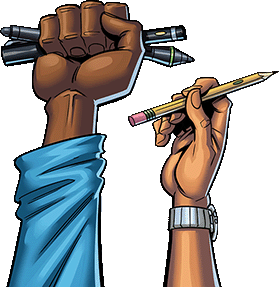How to Layout a Comic Book Cover
February 17, 2021
Although all the pages that come after it are important, your comic book’s cover is the most crucial part of your creative endeavor. If potential readers are turned off by the cover design, they will never crack open your book.
Designing a comic book cover is different from creating a comic book; it’s more artistic, and instead of a lengthy narrative, you have one shot to wow potential fans and get them to pick up your book.
By paying attention to content, placement, lettering, color, and theme, you can create a comic book cover that draws in new readers.
Don’t Abandon Your Headliner
Most comic book covers star the major character or the protagonist. An outstanding example is the first superhero comic – Action Comics #1 – that features the Man of Steel throwing a car. It’s a tried-and-true tactic that works.
You may be tempted to put your villain or antagonist front-and-center on your comic book cover, but play with that idea in your head for a while before committing to it. It may feel alternative and risqué to buck convention and show a different character than your principal on the front, but that may confuse your audience and impede the balance of your narrative.
Placement or Point of View
How we see the character on the cover of your comic book is almost as important as what’s on the inside. Ask yourself, from what point of view is the reader seeing the cover? Is it from the protagonist’s point of view?
Maybe from the antagonist’s point of view, watching the superhero’s fist come flying toward them. The layout of your cover and the coherence and power behind it rely heavily on the placement of the figures as well as the letters.
Lettering is Important
When choosing the lettering and theme for your comic book cover, the principal goal is that it remains consistent with the rest of your art. If you are the person who will be drawing your comic, then you should also be the one to create the cover.
Conversely, if you’re hiring an outside artist for the artwork, use the same artist as the one who’s penning the inside. This holds true for lettering as well. Having consistent lettering, especially on the front, is critical to a book’s cohesion.
Pick a Few Colors
It’s not unheard of to see a comic book cover in black and white, but it’s rare. A comic cover should grab your attention, and sometimes a two-tone cover won’t do the trick. Three or four contrasting colors, maybe including black for extreme contrast, can draw potential readers in and make them your fans.
Strong contrasts and bright colors can help your comic book stand out from the rest at the newsstand. You want to maintain a steady hand when picking your cover colors, as too many hues can make it too busy.
Theme is Essential
The theme is the general feeling or genre of your comic book. Although some books have themes that fall neatly into categories like film noir, it may not be easy to put into words.
As the writer and creator, you should be aware of your theme, even if it doesn’t fit neatly into one grouping or another. It’s much like the general feeling that your narrative gives off, and this should be apparent on the cover as well.
Common Cover Ideas
Over the years, comic books have fallen into reliable patterns when it comes to the artwork on the cover. Writers and artists have figured out what makes specific covers successful, and they’re able to transform that into their own success.
Here are some of the more common covers seen on the newsstand:
Battle Scenes
Showing a few of the characters locked in fighting stances pique readers’ interests. Often the protagonist is shown losing the fight to create more tension and strengthen the story. You can also choose an unusual angle or perspective to depict a fight.

Superhero Stance
Whether or not they’re superheroes, the protagonist can often be seen posing in the quintessential superhero stance – legs akimbo, hands on the hips, and a determined yet hopeful expression on their faces. Think of it like a portrait of your principal character and put them front and center.
Day-to-day Life
Successful covers often depict the protagonist and a few more characters following their usual routine; superhero families enjoying breakfast or an outing to the park are two splendid examples of how these could translate onto your cover.
Cities in Peril
Another classic is an urban center that’s being threatened by an outside force. When you think of Godzilla, you may see the classic shot of the monster tearing through Tokyo. Consider putting your own setting in a similarly perilous situation.
The Last Word
If you’ve been working hard on your comic book, save your strongest efforts for designing your cover. With powerful imagery, the right combination of characters and actions, and an arresting palette, you can draw readers in and make them turn to the next page.


